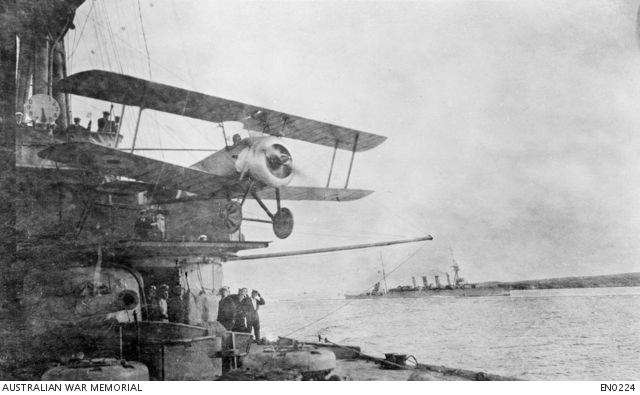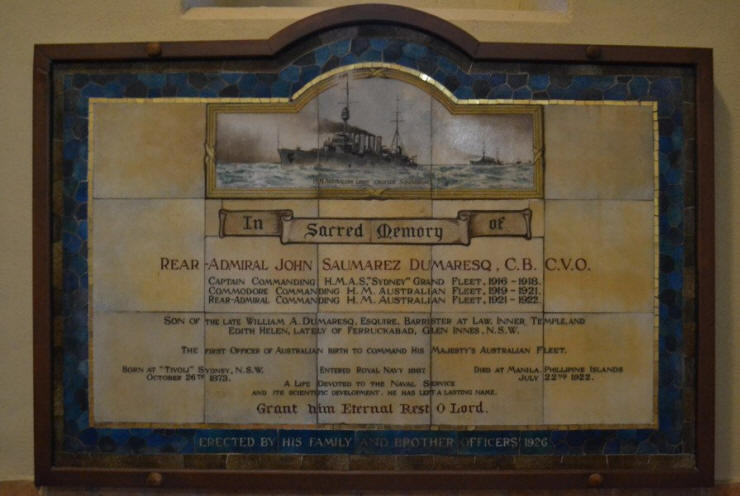
Navy Victoria
Network
Proudly supported by the Melbourne Naval Committee
Rear Admiral John Saumarez Dumaresq CB CVO RN/RAN
 John
Saumarez Dumaresq (1873-1922), Rear Admiral, was the first
Australian-born officer to command the Australian fleet.
John
Saumarez Dumaresq (1873-1922), Rear Admiral, was the first
Australian-born officer to command the Australian fleet.
He was born on 26 October 1873 at Tivoli House, Rose Bay, Sydney, son of William Alexander Dumaresq, pastoralist, of Furracabad station, Glen Innes, New South Wales, and his English-born wife Edith Helen, née Gladstone. Though Dumaresq was brought up in England from the age of 2, his family ties with Australia dated from 1825 when his grandfather, William John Dumaresq had come to New South Wales with his brother-in-law Governor Darling, and established an estate near Scone and large pastoral runs in the New England district.
On 15 July 1886 Dumaresq entered the Royal Navy as a cadet in HMS Britannia; he was commissioned Lieutenant on 28 August 1894 and after a period at sea with the Channel Fleet began to specialize in torpedo work. Promoted Commander in 1904, he was attached to the Admiralty to supervise the equipment of torpedo vessels. By then he was recognized as one of the navy's most innovative officers and he devoted much of his time to the science of naval warfare.
Switching his experiments from torpedoes to gun-room control, he invented a calculating instrument by which the rate of movement of enemy warships could be determined within seconds; this range-finder, named the Dumaresq by a grateful Admiralty, gave naval gunnery an unprecedented accuracy.

Dumaresq: named for its inventor, Lieutenant
John Saumarez Dumaresq,
this analogue device could take own ship's speed; and the enemy's
bearing,
course and speed, to calculate the rate of change of range and
deflection.
On 18 September 1907 he married Christian Elizabeth Louisa, daughter of Sir Charles Dalrymple, baronet. Next year he commanded the torpedo flotilla which escorted King Edward VII on his visit to the Tsar of Russia and for his services was appointed as a Member of the Royal Victorian Order (MVO). and awarded the Order of St Catherine of Russia. He was then appointed Commander of HM Ships Swift and the Nith, torpedo-boat destroyers of the Home Fleet.
A Captain from 30 June 1910, Dumaresq studied at the Royal Naval War College, Portsmouth, and invented several fire-control devices which were used in World War I. From December 1913 he commanded HMS Shannon, 2nd Light Cruiser Squadron. The Shannon led the squadron into action when Admiral Jellicoe's Grand Fleet intercepted the German High Sea Fleet at the battle of Jutland; Dumaresq's squadron was used to screen Jellicoe's six lines of battleships. For outstanding service in this action he was created Companion of the Order of the Bath (CB).
At Jutland he first conceived the idea of launching aircraft from the decks of cruisers rather than lowering them into the sea.
On 5 February 1917 he was transferred on loan to the Royal Australian Navy as captain of HMAS Sydney and the RAN's second senior officer. The Sydney at that time was with the 2nd Light Cruiser Squadron, Grand Fleet, and Dumaresq was the squadron's second-in-command. In May he took part in an action with a Zeppelin in the North Sea; with her six-inch guns the Sydney forced the airship up out of range but it then stalked the vessel, dropping bombs around it. With his back against the bridge-screen and his feet against the base of the compass Dumaresq became probably the first naval officer to develop the zig-zag system of bomb avoidance. For almost two hours he weaved in evasive action until the Zeppelin ran out of bombs.
In November, while the Sydney was being refitted, he commanded HMS Repulse in the battle of Heligoland: in a clash with the German flagship, Königsberg, the Repulse smashed her funnel and set her on fire.
The Sydney rejoined the squadron on 1 December 1917. The RAN's official war historian, A. W. Jose, wrote that, at this time, Dumaresq "was a man of exceptional ability and vivid imagination—an originator, both of novel devices and of tactical ideas. When he joined the Sydney he was in the thick of a campaign for inducing the Admiralty to use light cruisers against the Zeppelins which were at the time infesting the North Sea area—a scheme which in the end involved the installation of launching-platforms for aeroplanes on the cruisers".
Dumaresq was jubilant when, during the refitting of the Sydney, the Admiralty authorized installation of the first launching-platform to be fitted to a ship: one was later added to HMAS Melbourne. The first flight was successfully accomplished off the Sydney's platform on 8 December 1917 and the plane soon proved its value by driving off Zeppelins before they could get within bombing range of the ship. Dumaresq's planes again proved their worth when Admiral Beatty launched a raid on enemy minesweepers in Heligoland Bight in June 1918: two land-based enemy reconnaissance planes were flying towards the British ships when Dumaresq's pilots chased one off and shot the other down. He continued to command the Sydney until 28 February 1919 and for the next month was based in London.

A Sopwith F.1 Camel biplane aircraft takes off
from a platform
above the forward gun mounting on HMAS Sydney.
HMAS Melbourne can be seen in the background.
On 22 March Dumaresq was appointed Commodore Commanding the Australian Fleet, a post which brought fresh challenges. In June, when he was bringing HMAS Australia back from London to Sydney, the vessel stopped at Fremantle and about a hundred of the ship's company asked that her departure be delayed for one day. Captain C. L. Cumberlege, supported by Dumaresq, refused the request and later seven men were summarily sentenced to imprisonment and five court-martialled for mutiny and sentenced to longer terms. Dumaresq regarded the matter as one purely involving naval discipline and when the five men were eventually released through political pressure both he and Rear Admiral Edmund Grant, first member of the Australian Naval Board, tendered their resignations. These were later withdrawn.
Dumaresq was appointed a Commander of the Royal Victorian Order (CVO) in 1920. He was promoted rear admiral in June 1921, becoming the first Australian-born officer to hold that rank and to command the RAN. He brought to the small but professional Australian navy very high standards of discipline and competence. The measure of his success was the long succession of distinctions gained by RAN officers attending Royal Navy training establishments and, ultimately, the high standard of leadership in the RAN in World War II.
His last notable exploit took place in January 1922 when he was proceeding to New Zealand aboard his flagship, HMAS Melbourne, when, in a cyclone in the Tasman, the radio operator picked up an SOS from the sinking four-masted schooner Helen B. Sterling, and proceeded to effect a spectacular and gallant rescue. The SOS call stated, ‘We are waiting for her to go down’. The message was received by the crew of Melbourne, who set out in search of the stricken vessel. They sent a message in reply, which simply read, ‘We are certain to find you. Keep good heart’. At midnight, the crew spotted the sinking schooner with the aid of searchlights. It was far too rough to get the cruiser alongside the schooner, so Melbourne launched its cutter with a 16 man volunteer crew to row across to the sinking vessel. Once they were close enough the cutters crew fired a line across to the schooner and then rigged a breeches buoy (basically a flying fox) which was used to bring the crew over to the cutter one by one.
Amongst those rescued was the Master of the Helen B Sterling, Captain G.R. Harris, his wife, and their 12 year old son, who was on his first trip to sea. Once on board the cutter the crew of the Sterling were rowed back to the Melbourne and then taken to Auckland, New Zealand where they were disembarked. Subsequently, the 16 men who manned Melbourne's cutter were each awarded a gold medal by the President of the United States for their skill and valour in effecting the rescue.
The master's son, Leslie Harris, received various pieces of memorabilia following the rescue, among them an HMAS Melbourne tallyband which was eventually passed on to his grandson, Michael. Michael went on to join the RAN, and in 2009 Commander Michael Harris became the Commanding Officer of HMAS Melbourne (III).

Oil on Canvas by Tim Johnson - 9 November 2009
Commissioned by CMDR Mick Harris of the Royal Australian Navy.
This painting depicts the rescue of the crew and passengers of
the schooner HELEN B. STERLING by HMAS MELBOURNE in 1922.
The stringent financial restrictions imposed on the Australian Fleet from 1920 brought Dumaresq into constant conflict with the Australian government as he sought to protect the navy's interests. His service with the RAN ended on 29 April 1922 when he reverted to the Royal Navy. Speaking on his flagship before leaving Sydney, he strongly criticised the attitudes and apathy of the nation towards defence expenditure. He left for England on the Japanese liner, Tango Maru, but on nearing the Philippines, fell ill with pneumonia and died at the American Military Hospital, Manila, on 22 July. In a ceremony attended by 1200 United States troops, he was buried in San Pedro Macati cemetery with full military honours. He was survived by his wife, two sons and two daughters.
Historical Ties
The website of the Australian Embassy in the Philippines states: Historical military ties between Australia and the Philippines date back to 1922 when Rear Admiral John Saumarez Dumaresq CB CVO, the captain of HMAS SYDNEY during the last two years of the First World War (1917-1918) and the first Australian born commander of the Australian fleet (1919-1922), was accorded the equivalent of a State Funeral in Manila. Rear Admiral Dumaresq died of illness in Manila while returning to the United Kingdom after completing his term as commander of the Australian Fleet and is buried in Manila Memorial Park, Paranaque.

Although a strict disciplinarian 'D.Q.', as he was known in Australia, was popular with all ranks and gave the navy a spirit it had never possessed. Of a cheerful disposition, he soon had the whole fleet involved in off-duty sports while he himself regularly took part in yachting events on Sydney Harbour. He detested personal publicity. His contribution to the RAN had been considerable. He had brought the fleet to a high standard of efficiency despite the severe restrictions of the period and had welded it into a highly proficient force after its dispersal during the war years.
Sources:
Australian Dictionary of Biography
Australian War Memorial
Naval Historical Society
Death of a shipping line: The rise and fall of the Sterlings
Tim Johnson's Virtual Gallery
Royal Australian Navy
Royal Australian Navy-Ship Histories